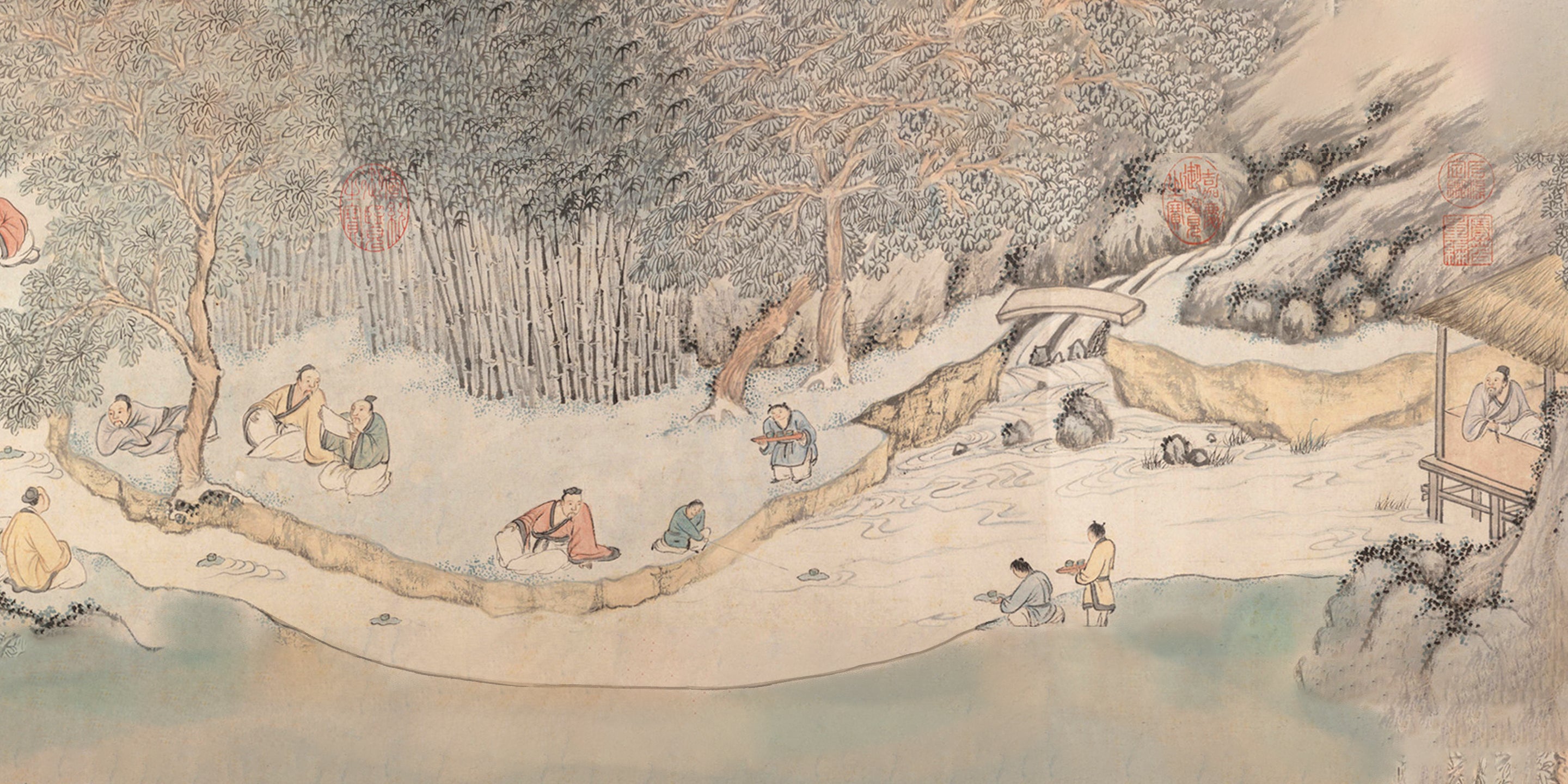
China's Most Beautiful Calligraphy Honored in Shen Yun Collections Design
Brett Chuda, Contributing Writer
Imagine Shen Yun dancers performing onstage while one of China's most beloved works of calligraphy appears stroke by stroke. Animated on the backdrop behind the dancers, it's as if an unseen hand is writing it in real time.
That's the experience audiences had in the Shen Yun dance piece Poets of the Orchid Pavilion from the 2016 season. The performance was more than 1,600 years in the making, beginning with an ancient work of calligraphy known as the Preface to the Poems Composed at the Orchid Pavilion. The dance and calligraphy are now immortalized in a stunning blue and white silk scarf from the Shen Yun , part of a collection of matching accessories that don the enchanting literary treasure.
In China's 5,000-year history, the calligraphy found in the Preface stands apart from all others as the most beautiful example of running script ever created. The calligrapher who made it could never match or surpass its beauty and inner spirit, though he tried. In its day, it was recognized as a masterpiece and has been copied by generations of masters. It's still transcribed today by aspiring calligraphers and poets. The famous emperor Taizong of the Tang Dynasty loved it so much he commissioned it to be engraved into stone in the 7th century and is said to have taken the original scroll to his grave with him.
While the sentiments expressed in the Preface are deep and inspiring, the calligraphy is more famous than the literature itself. Its beauty is typically described with Chinese expression “floating clouds and flowing water” (行雲流水).
How was it produced? A group of scholars gathered at the Orchid Pavilion on Mt. Kuaiji for a poetry contest over drinks. Many of the poems composed, inspired by the stunning landscape, became famous in their own right. But, it was the preface to the poems, written by the Sage of Calligraphy, Wang Xizhi, that became most noted and has gone down in history as a masterpiece.
Now in traditional blue and white porcelain colors, the Shen Yun has recreated the poem on an elegant silk scarf embellished in the classical style with mountains and streams.

The scarf's border design uses the collar pattern from the costume worn in the 2016 dance piece. It runs from one orchid-filled square to the next. Orchids are one of the most important symbols in Chinese art. Orchids are known for their ornate and gorgeous beauty that grows in a variety of locations in the wild: on trees, from rocks, or along water.
Back at the gathering of scholars on Mt. Kuiji, orchids, along with flowing water, were the cause celebre that early Spring day because, in ancient China, people believed those two living symbols would help shoo away winter's nastiness. Servants at the gathering sent floating cups of wine downstream, and where they stopped the nearest guest had to compose a poem on the spot—or drink three cups as penalty. Of the 41 guests, 26 composed a total of 37 poems, inspiring Wang to pen his famous Preface.
In subject matter, the Preface is a simple description of the poet’s musings—but written so elegantly, so masterfully that it leaves a deep impression. Phrases include “airy as a cloud, yet with strength to startle dragons;” taking “flight beyond heavenly gates;” like “tigers lying in wait” and as guards before a “phoenix pavilion.”

Main text of an early Tang Dynasty copy of Wang Xizhi's Lantingji Xu by Feng Chengsu.
Having a sense of how beautiful its contents are makes it even more amazing that the form, the script itself, remains the most enduring aspect of the artwork. Besides its rich cadence, it's said that it is constant in its inconstancy. For example, the character 之 (pronounced zhī, meaning “of,” and also part of Wang Xizhi’s name) shows up 20 times, but each time its written differently, carrying unique stylistic flavors.
For a calligraphy sage, Wang was also a masterfully candid poet. In his Preface lies an appeal to us, the present-day readers—and even to future ones. He predicts that later generations “will look upon us just as we looked upon the past.” The joys and disappointments of living, the cherished memories of happiness, are but a blink of History’s eyes. But even though time may change, human sentiment will not.
He observes life and shares it with us. The “causes for feelings and mood remain the same,” he says, metaphorically extending his hand to ours.
“Read me and see,” he coaxes. “We are not so different, you and I.”
The Shen Yun designers have included Wang's complete Preface on both styles—one square and one oblong—of their porcelain-like silk scarves. Diminutive orchids are featured across their borders, amid dramatic and misty mountain landscapes, just as the orchid was honored at the poets' mountainside gathering so long ago.
Click here to see the scarves' timeless color combination and start imagining new looks for yourself today!You May Also Like
2 comments
So interesting, I love reading episodes from history to understand how they effected us in the present. This a beautiful and moving story. Philosophical even. Thank you so much for the depth of the knowledge you’re sharing.
What an amazing story! Thank you so much for sharing. I love these historical references blogs you post. Please keep them coming!





















